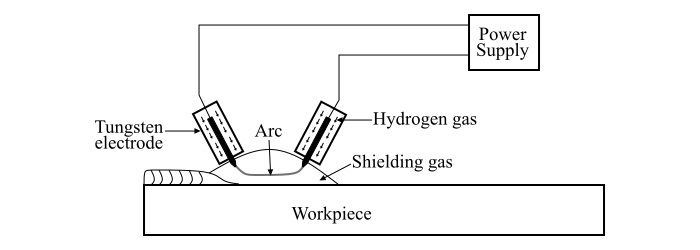
 Data Structure
Data Structure Networking
Networking RDBMS
RDBMS Operating System
Operating System Java
Java MS Excel
MS Excel iOS
iOS HTML
HTML CSS
CSS Android
Android Python
Python C Programming
C Programming C++
C++ C#
C# MongoDB
MongoDB MySQL
MySQL Javascript
Javascript PHP
PHP
- Selected Reading
- UPSC IAS Exams Notes
- Developer's Best Practices
- Questions and Answers
- Effective Resume Writing
- HR Interview Questions
- Computer Glossary
- Who is Who
Atomic Hydrogen Arc Welding – Working, Advantages, Disadvantages and Applications
The atomic hydrogen arc welding is an arc welding process which uses an arc between two tungsten electrodes in a shielding atmosphere of hydrogen. The atomic hydrogen arc welding was invented by Irving Langmuir.
The essentials of the atomic hydrogen arc welding are as follows −
The electrical energy is supplied to create an arc between two tungsten electrodes where it is transformed into heat.
The source of electrical energy could be either DC or AC, but in practice, AC supply should be chosen as it is commonly available.
Molecular hydrogen is blown through the arc and transformed catalytically into the atomic form which acts as a carrier for transfer of energy from the arc to the work-piece.
In the direction away from the arc, a sudden decrease of temperature causes the rapid decrease in the concentration of atomic hydrogen and a release of the heat of recombination.

Working of Atomic Hydrogen Arc Welding
In the atomic hydrogen arc welding, to strike and maintain the arc, an open circuit voltage of 300 Volts is necessary and a current range up to 50A is required. This power is obtained from a transformer which is having a number of primary tappings to allow for various supply voltages and a tapped reactor to allow the adjustment of the current.
In the atomic hydrogen arc welding process, the arc is created between two tungsten electrodes and molecular hydrogen passes through this arc.
The molecular hydrogen changes to its atomic form due to the high temperature (about 4000 °C) of the arc.
When the atomic hydrogen travels to the cooler regions in the vicinity of the arc, it regains its molecular form.
In this process, the hydrogen gives up the energy which it had received from the arc.
Consequently, a very intense heat is produced which is used to melt the work-piece to be welded.
After cooling, the two parts of the work-piece are welded together. Also, a filler rod may be used if extra metal is required for making the joint.
The atomic hydrogen arc welding is mainly used for welding stainless steel and most non-ferrous metals, etc.
Advantages of Atomic Hydrogen Arc Welding
The advantages of the atomic hydrogen arc welding are given as follows −
With the atomic hydrogen arc welding quite thick sections can be welded.
The atomic hydrogen arc welding gives strong, ductile and sound welds.
Atomic hydrogen arc welding can be used for materials which are too thin for gas welding.
In the atomic hydrogen arc welding, the arc and the weld zone are surrounded by burning hydrogen which protects them from atmospheric contamination.
The tungsten electrodes remain cool because of the flow of hydrogen gas. It increases the life of the electrodes.
Disadvantages of Atomic Hydrogen Arc Welding
The disadvantage of the atomic hydrogen arc welding are as follows −
The atomic hydrogen arc welding process is expensive than the other types of welding processes.
Atomic hydrogen arc welding requires skilled operator.
Atomic hydrogen arc welding can be used in flat position only.
As the hydrogen is highly inflammable, hence this welding process is riskier.
Applications of Atomic Hydrogen Arc Welding
The atomic hydrogen arc welding is used in following applications −
Atomic hydrogen arc welding is used in the applications where fast welding process is required such as for welding the stainless steel, etc.
This welding process can be used for welding most of the ferrous and non-ferrous metals.
It is used for very precision welding.
It is also used for welding thin sheets of metal.

